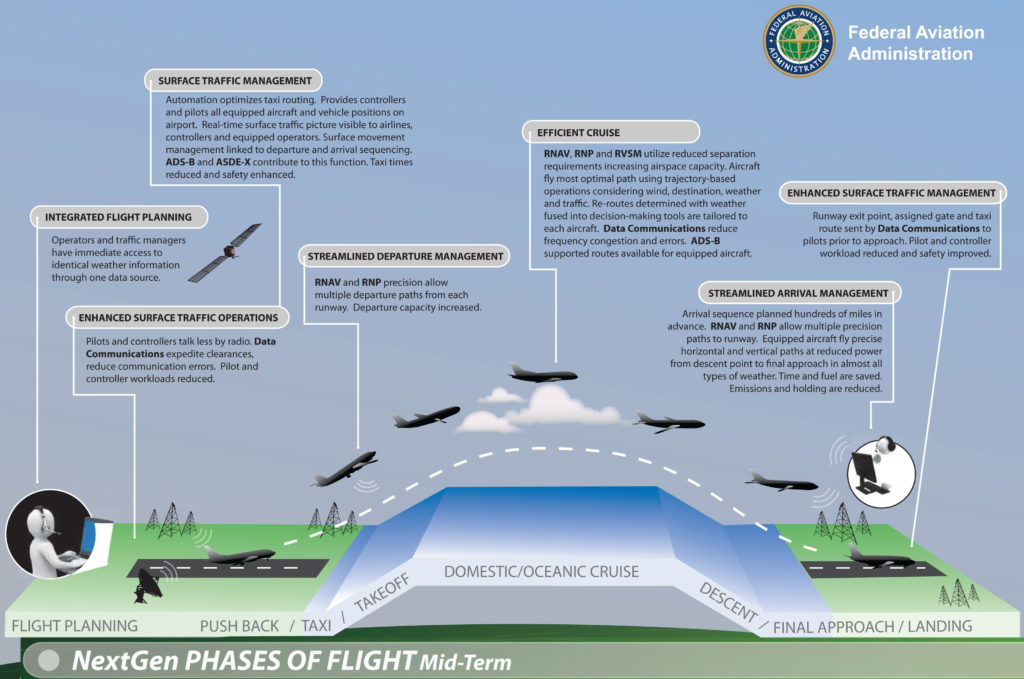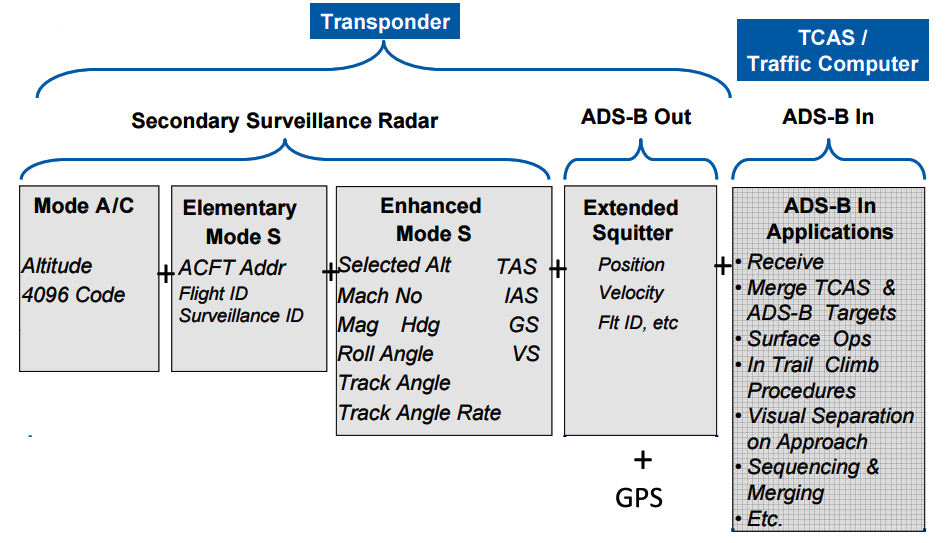Leeham News and Analysis
There's more to real news than a news release.
Bjorn’s Corner: Transponders, the kingpin of safe air navigation, Part 3.
June 3, 2016, ©. Leeham Co: Over the past few weeks, we have described how transponders go from being little more capable than the WW2 IFF that they were developed from, to how they will act as information beacons, sending the aircraft’s ID, position and speed to all surrounding listeners every second.
The consequences of this change are nothing short of revolutionary. From a situation where the ground controller or adjacent aircraft had scarce information on the multitude of aircraft they tried to track, Figure 1, they can now receive all the information they need from the aircraft under observation.
This, together with other technologies like data link-based communication, will change Air Traffic Management as we know it.
What’s needed in addition to ADS-B out
The information beacon we talk about is the aircraft being equipped with an ADS-B class transponder sending the aircraft’s ID, position, speed and lots of other information to everyone what care to listen around the aircraft or on ground. How all this is done we explained in last weeks corner. We then also mentioned that the future transponder will also be capable to receive information via ADS-B In, Figure 2.
The ADS-B In capability will be used for a more capable Traffic Collision Avoidance System (TCAS, see below) but also to receive global information like a unified Weather picture. This is important as all stake holders in the future ATM will then see and act on the same weather information, be it close to an airport or underway.
Another important component will be that today’s radio traffic will to a large extent be replaced with data link messages. This sound scary but it is not. It has the same advantages as the mail message we use in everyday life/business. It’s a quick, clear way to communicate what’s agreed in a clear standardized language for everyone to read.
The message can also be re-read at a later instant when one wonders if one got the Air Traffic Controllers (ATC’s) message correct. And the messages back to the ATC shows that the Pilot “got it” and will comply. The standardized messages will also allow computer processing of the info on both sides, enabling, e.g. that an ATC change in flight plan goes automatically into the FMS for the pilot to only press “accept.”
Data link communication also increases communication capacity in a big way. Today’s radio traffic might be cool and a bit personal, but it’s an ineffective way to convey safety critical messages between ATC and Pilots. There are several garbled messages each day due to simultaneous pressing of the send button between participants.
Controller-Pilot Data Link Communications (CPDLC) is already in use in Europe on a trial basis. Over 30 airlines use it when navigating Eurocontrol’s upper airspace. It needs an additional smaller display on legacy airliners but occupies only a small part of info displays on new aircraft (like the Airbus A350 I flew).
Traffic Collision Avoidance Systems, TCAS
Future Air Traffic Management will need a more effective TCAS system than today’s, which is limited in its directional resolution and therefore does not allow real close separation of aircraft (false TCAS messages would be the result).
Today’s TCAS system builds on the interrogating aircraft having directional antenna systems so that the direction to the responding aircraft can be determined (range comes from the go-around time for the interrogation and altitude from the Transponder’s C or S response). Such antenna systems have coarse directional capability and requires the installation of two additional antennas on the aircraft.
With ADS-B based TCAS, all aircraft tell the system where they are and are going, therefore a TCAS function only need to listen to the ADS-B Out info with its ADS-B In capability. Then it can do all calculations needed for aircraft-to-aircraft based separation.
This means that in the future TCAS functions will be standard in integrated avionics offering and not elaborate and expensive add-ons to an avionics stack. It will mean that TCAS will be common in commercial, military and general aviation aircraft. Competition in the avionics market will ensure that this will be available at reasonable prices in the future.
Until all aircraft are equipped with ADS-B, today’s TCAS will be enhanced with ADS-B to allow closer separation for airspaces where ADS-B will be mandatory.
Air Traffic Management
Both the US and the European agencies that are responsible for Air Traffic Management (ATM) in their regions have announced the programs that will gradually change the present ATM to a future model based on the advantages of ADS-B and data link messaging (legacy navigation means and radio communication will still complement and form the back-up layer).
The US program is called NextGen (Next Generation Air Transportation System) and the European SESAR (Single European Sky ATM Research).
They both build on the fact the movements around airfields (Standard Instrument Departures, SIDs and Standard Arrival Routes, STARS) can be made more direct and optimal with ADS-B based navigation and that routes at cruise level can be flown in a more direct fashion.
Figure 3 is a graph from FAA which gives a good overview of the techniques used and their benefits.

Figure 3. NextGen Air Traffic Management using ADS-B and data link messaging. Source: FAA. Click on image for better view.
The ASDE-X system which is mentioned in the graph is a present day system using a mix of SSR interrogation, ATC information and ground radar to enhance airport traffic management both on the ground (aircraft and vehicles) and in the air for aircraft close to the airport.
The graph shows how ADS-B and data link communication enhances ATM in all aspects of flight, from chocks off before take-off to chocks on after landing.
The transformation will take time
The NextGen transformation of STARs and SIDs in a few busy areas (Metroplexes) have started based on RNAV procedures and it has become clear to everyone that it will be a process that needs time and will have to be taken in steps. Established procedures have taken a lot of factors into account and new ones must factor in that Air Traffic Controllers and Pilots need time to adapt in a safe way to a changed situation. Some first NextGen trials have gone well (Washington DC and Denver Metroplexes upgrades), other have demonstrated the problems involved (North Texas Metroplex upgrade).
There is no one doubting the base technology and the end target, it is just that the route there involves the work with human beings and these need a professional change process to make the corner in a safe way.
When ATC feels they already is controlling the existing procedures so that they become very effective, they see little need for letting new procedures and computers take over. Especially when first results of straightening routes and allowing direct idle decent to the runway proximity gives marginal improvements in fuel burn.
The different results achieved in FAA’s NextGen pilots show the magnitude of the task at hand. But change is inevitable. The present ATM can’t handle the traffic increase which is coming, the advantages in both capacity, safety and cost of the future ATM is a necessity.





Re weather information, a couple of years ago a Virgin Australia 737 landed in Mildura without enough fuel for a go-around, curtsy of wrong weather info, they diverted thinking Mildura was clear, it was covered with fog, after several failed attempts to land it was do or die. Up to date weather is still not as good as it should be.
I agree text messages are best, once people get used to them. At work I want everything written I can get, re-readable=peace of mind.
The controllers likes it as well
Newark trials
Especially good if an aircraft has to be re-routed due to weather and it is near the limit, or met got it wrong with the first choice, like the above mentioned Virgin Australia case. 12 min can be a long time to fly in the wrong direction if you have to go for an alternate destination.
Re TW´s comment below I can think of several cases where a single company or a small country have introduced their own inventions and seen it become a world wide thing. Original thinking isn´t confined to governments or universities.
Agreed. Test or email also ensures that everyone who is involved can critique it and comment that it is not correct.
world of mouth is the worst method of communication possible.
Text also makes it accountable as to who set it going wrong if it does.
I would proudly like to note that the predecessor to ADS was the Western Alaska Capstone project by the local FAA region as a trial program to reduce the accident rate in Alaska (one of the worst places in the world that has regular commercial flights due to terrain, awful and rapidly changing weather and air being the only real link many community have)
Alaska Airlines then asked it be extended to Southeaster Alaska as one of the worst approaches in the world into Juneau is down there (and they had one major fatality when they lost situational awareness)
Pretty amazing for this to have exploded into todays ADS system I think.